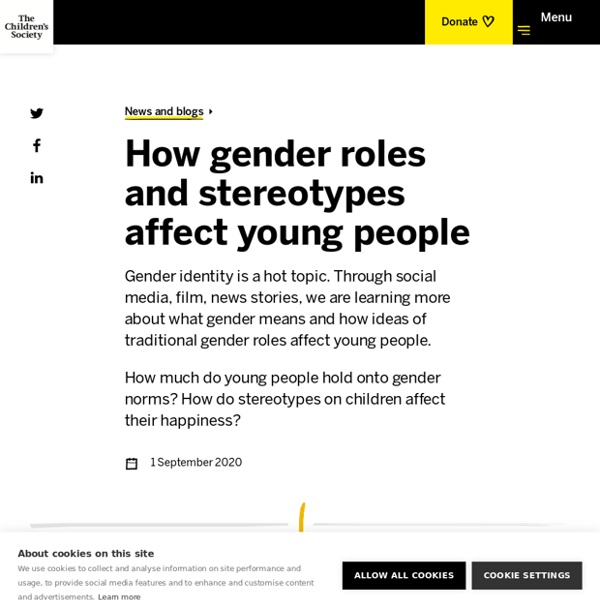



https://www.childrenssociety.org.uk/what-we-do/blogs/how-gender-roles-affect-young-people
Related: Social learning theory: Gender roles and identities • Social Learning Theory • Understand how children learn about gender roles and identities through social learning theoryThis is what happens when gender roles are forced on kids Story highlights A first-of-its-kind study looks at early adolescent gender identity development around the world Enforced gender expectations could lead to health inequities between boys and girls “This is Life with Lisa Ling” explores young people expanding beyond traditional gender binaries Sunday at 10 p.m. ET/PT. You’ve probably heard it before: More than biology, family, friends and society influence impressions of what it means to be a boy or a girl, placing rigid gender expectations on children from a young age.
Gender Identity Development in Children By: Jason Rafferty MD, MPH, EdM, FAAP There are many ways parents can promote healthy gender development in children. It helps to understand gender identity and how it forms. What's the difference between gender and sex? Being a boy or a girl, for most children, is something that feels very natural. At birth, babies are assigned male or female based on physical characteristics. 5 Tips for Preventing and Reducing Gender Bias — Making Caring Common 3. Help Kids Kick Stereotypes to the Curb Why Kids are often unaware of the gender biases and stereotypes they confront every day, biases and stereotypes that can powerfully shape their views of gender. Kids need to learn from the adults in their lives how to recognize bias in themselves and others, how to talk constructively to others about biases, and how to avoid being influenced by stereotypes
Beyond ‘He’ or ‘She’: The Changing Meaning of Gender and Sexuality In Park City, Utah, students are lining up at a local high school to get their locker assignments for the semester. Extracurricular clubs have set up tables to attract new members. It’s only midday, but the Gay-Straight Alliance, a group with outposts at about a quarter of American secondary schools, already has 47 names on its sign-up sheet. Sitting behind piles of rainbow-colored paper cranes — a hot fundraising item — the group leaders are counting the different identity labels they’ve encountered. Sure, there’s lesbian, gay, bisexual, transgender. Gender identity Gender identity refers to the deep and intimate feeling a person has of themselves. Children begin to understand and express their gender identity early in life. This article discusses how gender identity typically develops and how parents and caregivers can promote healthy development of gender identity and expression in children. It's important to remember that each child is unique and may develop at a different pace. What we mean by gender: Some useful definitions Sex at birth: When children are born, sex is assigned based on external genitalia.
The Harms of Gender Stereotypes On Young Kids – The New Normal Whether it is enforced consciously or not, children grow up with the perception that men are the dominant, strong sex while women are the more emotional and vulnerable sex. By age six, children have formed a rigid idea of how each sex behaves and how they should be treated (“Healthy Gender”). When puberty hits, the pressure to conform to these ideas influence the identity of these children (Grinberg). Harmful Gender Norms & Roles Can Create a Lifelong Cycle of Gender Inequality All children deserve to grow up and achieve their dreams – regardless of their gender. Tragically, inequitable gender norms rob millions of girls and boys of their childhoods – and risk their futures. Often, these damaging expectations directly contribute to the violation of children’s human rights. Gender norms describe how people of a particular gender and age are expected to behave in a given social context. Harmful gender norms result in many types of inequalities between girls and boys.
Albert Bandura's Social Learning Theory Albert Bandura's Social Learning Theory By Saul McLeod, updated 2016 Social learning theory, proposed by Albert Bandura, emphasizes the importance of observing, modelling, and imitating the behaviors, attitudes, and emotional reactions of others. Social learning theory considers how both environmental and cognitive factors interact to influence human learning and behavior. In social learning theory, Albert Bandura (1977) agrees with the behaviorist learning theories of The Social Learning Theory Explanation for Gender Differences - HubPages What is the Social Learning Theory's Ideas about Gender Differences? The social learning theory or social learning approach also provides an insight into how and why gender differences arise. Unlike the biological approach, social learning theory suggests that our gender differences arise from our socialisation - our interactions with other human beings. To see the other explanations for gender differences see: Key Principles of the Social Learning Theory about Gender Differences
What media teach kids about gender can have lasting effects, report says Story highlights Gender stereotypes are incredibly effective at teaching boys and girls what the culture expects Luckily, parents can assert control over the messages that Hollywood dishes out Gender stereotypes are messing with your kid. It’s not just one movie. It’s not just one TV show. Social Learning Theory of Gender by Bandura - ScienceAid Edited by Jamie (ScienceAid Editor), Taylor (ScienceAid Editor), MaxScience, Sharingknowledge The Social Learning Theory was proposed by Bandura as a way of explaining how children acquire their gender identity based on the influence of other people (particularly their parents). Stages of Learning There are four stages that a child goes through when develop gender behaviour. These are:
What Is Gender Identity? Gender is separate from sex. Although genetic factors usually define a person's biological sex, people determine their own gender identity. This article explores what gender identity is, definitions of various gender identities, and where individuals can find support. What Is Gender Identity?
Children are being brought up in a stereotypical society that still places a lot of emphasis on traditional gender norms. These norms can be seen in children's beliefs but also their unhappiness when they don't meet these norms. by katielou21 Jan 20